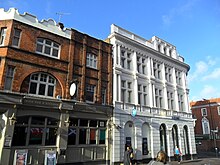Sutton High Street

A view of Sutton High Street within its Conservation Area section
|
|
| Length | 0.9 mi (1.4 km) |
|---|---|
| Postal code | SM1 |
| north end | Angel Hill 51°22′18″N 0°11′40″W / 51.3718°N 0.1945°W |
| south end | Brighton Road 51°21′33″N 0°11′29″W / 51.3593°N 0.1913°W |
Sutton High Street is a high street running north-south through the town of Sutton in the London Borough of Sutton.
The High Street area constitutes the sixth most important retail centre in London, and is home to many restaurants and major retail names. It is pedestrianised for most of its length, and a conservation area runs down a three hundred yard section. There are three examples of public art in the street, and parks at either end of it.
The section of road that is now Sutton High Street dates from the Middle Ages, and developed into part of the main road from London to Brighton. By the 18th century Brighton's popularity as a coastal resort was growing, and the route was well used, but not yet regularly maintained. This was put right in 1755 when the enacting of turnpike legislation provided a means for the road's better maintenance. This, combined with its intersection with the east-west Carshalton/Cheam Road, led to the development of a small settlement around the tollhouse in what is now the centre of the town. By the beginning of the 19th century Sutton had become a fully-fledged village, and the road was dotted with a number of houses, pubs and shops from Sutton Green southwards up to the Cock crossroads. The road was used frequently by the Prince Regent to access Sutton Lodge on Brighton Road, and, being the main route to Epsom Downs, it was also heavily used by visitors to the Epsom Derby. In 1801 the population of the town stood at 579, at that point lower than the other settlements in the borough. However, by 1861 it had risen enough to make Sutton the largest settlement in the borough.
Their position on the London to Brighton turnpike provided the village's two large coaching inns, the Cock and the Greyhound, with trade serving coaches travelling through the village. The Cock Hotel's sign straddled the Brighton road, and its proprietor was the champion pugilist, "Gentleman" Jackson. The building was demolished in 1898, shortly after a new Cock Hotel had been constructed on a directly adjacent site to the north. Its name originated from the cock horses needed along this part of the road. Twenty horse and carts passed up and down this stretch in a day. Regular contact beyond the town brought both expansion and sophistication. Small businesses opened up, at first directly related to travellers on the turnpike – bakers and brewers to feed visitors, seamstresses to provide running repairs, leather workers to make or mend harnesses – and then to provide trade goods for neighbouring communities.
...
Wikipedia
